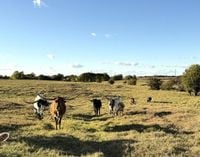For decades, beef has been at the heart of the American dinner table and the backbone of rural economies from Colorado’s sprawling plains to the rolling pastures of Arkansas and Oklahoma. But behind the sizzle of a steak lies a simmering controversy—one that’s pitting cattle ranchers against policymakers, multinational corporations, and even the very consumers who crave affordable meat. The spark? President Donald Trump’s recent decision to quadruple the amount of Argentinian beef allowed into the United States at preferential tariff rates, a move that’s sent shockwaves through cattle country and ignited a fierce debate about the future of American beef.
On November 4, 2025, President Trump announced the increase in the tariff rate quota for Argentinian beef from 20,000 to 80,000 metric tons. The stated goal: to lower beef prices for American consumers and support Argentina’s embattled economy—especially under the leadership of Trump ally, President Javier Milei. According to the White House, this policy followed a $20 billion currency swap with Argentina, a gesture of economic solidarity during tough times for the South American nation.
But for many American cattle producers, the news landed like a punch to the gut. In Colorado, where nearly half the land is dedicated to farmland—most of it raising cattle and calves, the state’s biggest cash crop—the prospect of cheap Argentinian beef flooding the market has triggered bipartisan outrage among legislators. As reported by Colorado Newsline, the announcement has already hurt cattle prices, undermining what little relief ranchers have found after years of drought, disease, and razor-thin margins.
The reaction was just as swift in Oklahoma, where beef production pumps $2.7 billion into the state’s economy and exports hit $433 million in 2023. “We’re going to have record high beef prices for quite some time,” said Derrell Peel, an agribusiness professor and livestock marketing specialist at Oklahoma State University, in an interview with the Oklahoman. “They’re record high and very volatile right now. Very, very uncertain.”
Peel pointed to a jaw-dropping statistic: over the past five years, the price of rib-eye steak has soared from about $13.13 per pound to $25.59 per pound, with retail markups sometimes exceeding 300%. While these high prices sting at the register, they’ve also been a lifeline for ranchers battered by drought, high feed costs, and a shrinking national herd. The United States now has its smallest beef cow herd since 1961—a direct result of what Peel calls the “10-year cattle cycle,” compounded by severe weather and economic headwinds.
Yet, Trump remains adamant that his policy is a boon for both consumers and ranchers. On his Truth Social platform, he declared, “The Cattle Ranchers, who I love, don’t understand that the only reason they are doing so well, for the first time in decades, is because I put Tariffs on cattle coming into the United States, including a 50% Tariff on Brazil. If it weren’t for me, they would be doing just as they’ve done for the past 20 years – Terrible! It would be nice if they would understand that, but they also have to get their prices down, because the consumer is a very big factor in my thinking, also!”
But many ranchers aren’t buying it. In Arkansas, the eleventh largest cattle-producing state—where small, family-run ranches dominate—the announcement caused what the Arkansas Farm Bureau described as “multiple days of steep losses.” Coby Wilson, the bureau’s director of commodity activities and economics, told KATV, “Just the mention of increasing imports from Argentina sent the cattle markets into multiple days of steep losses.” Feeder prices fell by $30 to $40 per hundredweight, and calves dropped $40 to $50. For a rancher selling 200 head, that’s a potential loss of $16,000 in a single week.
Jeremy Cox, an Independence County rancher and stockyard owner, expressed a sentiment echoed by many: “The White House probably should not have said some of the things that they’ve done, because it caused us a disaster almost.” The pain is particularly acute for smaller operations, which lack the financial cushion of larger outfits. “They’ve got to allow us to make money or the younger people ain’t coming in. They just won’t come in,” Cox warned. “If they can’t make money, they’re not going to do it. And if they can’t make money and not do it, you ain’t seen high beef prices.”
So, will the influx of Argentinian beef really lower prices for shoppers? Most experts say: not much, if at all. Michael Kelsey, executive vice president of the Oklahoma Cattlemen’s Association, told the Oklahoman, “Our best economic models indicate it might lower the (ground beef) price 6, 7, 8 cents a pound.” That’s a far cry from the kind of relief consumers might expect. Chad Daniel, owner of 777 Farms in Magnolia, Arkansas, argued, “I don’t really think it affects overall, the whole beef price and everything, or it shouldn’t, because we import 12 percent of our beef as an industry.”
In fact, Argentina accounts for only about 2% of U.S. beef imports, and as Peel noted, “The effect of all of that is Argentina is not going to have any impact on beef prices in the US.” With Brazil’s imports dropping due to high tariffs, any increase from Argentina is likely to be offset elsewhere. Senator Tom Cotton of Arkansas summed up the skepticism, telling KATV, “I think the proposal bringing more Argentine beef is ill advised. Not only does it have a detrimental effect on the price of cattle...it probably won’t do much to bring down the price of beef at the butcher counter in your grocery store.”
Meanwhile, the structure of the U.S. beef industry complicates matters further. The so-called “Big Four”—JBS, Cargill, Tyson, and National Beef—control 80% to 85% of the market. According to Colorado Newsline, these corporations have a history of price fixing, environmental violations, and labor abuses. They’ve paid tens of millions in settlements, and their dominance has squeezed independent ranchers: where producers once earned 60 cents for each dollar of beef sold, today they get just 30 cents. More than half of America’s cattle producers have gone out of business since 1980.
Critics argue that the Big Four—not consumers or small ranchers—stand to gain the most from Trump’s new policy. Lower tariffs will reduce their production costs, but there’s little evidence those savings will be passed on at the checkout. Instead, the corporations are likely to pocket the difference, further consolidating their grip on the industry. As Darin Harper, a Carroll County butcher, put it, “If they’re looking for a $2.99 hamburger again, that’s not going to happen. Right now, even our cost of the materials that I use to make my ground chuck is over $6.50 a pound, and I’m charging $7.99 a pound for a hamburger, which is no profit by the time it runs through the house.”
While the U.S. Department of Agriculture has announced long-term plans to help rebuild the nation’s cattle herd, experts warn that progress will be slow. “It takes about 2 ½ to 3 years to go from a bred heifer to calf to pot roast,” Peel explained. Until herd numbers recover, high prices are likely here to stay—and so is the tension between those who raise America’s beef and those who set its policies.
As the dust settles, one thing is clear: the battle over beef is more than just a fight over food. It’s a struggle for the soul of rural America, a test of government intervention versus market forces, and a stark reminder that in the world of steaks and burgers, every decision has consequences that ripple far beyond the ranch gate.






